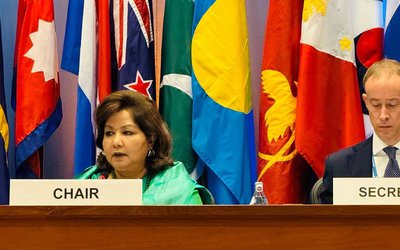More on National





Seven years after the signing of the peace process and conclusion of violent Maoist armed conflict, the Geneva-based Office of the High Commissioner of Human Rights (OHCHR) published its report on the Maoist conflict in Nepal. The last minute effort of Nepal government to stall the conflict mapping report failed and the report is now public.
Many people involved in the Maoist conflict in one or the other way, however, have already joined the political mainstream and have become ministers and prime ministers, how the conflict mapping report will help to heal the wounds of the victims of conflict remains to be seen.
At a time when UCPN-Maoist chairman Pushpa Kamal Dahal Prachanda and senior leader Dr. Baburam Bhattarai, under whose orders and command, the 12-year long deadly conflict was fought, became prime ministers and most of the UCPN-Maoist leaders who were directly or indirectly involved in human atrocities got the cabinet berths, the OHCHR mapping report is likely to raise more questions over the legitimate security personnel of the state.
“It is unfortunate that human rights activists are raising the right violation issues criticizing some senior officials of Nepal Army and Nepal Police. However, they are not raising any concern on rights violators who became ministers and prime ministers,” said Rajendra Bahadur Thapa, retired brigadier of Nepal Army.
The report was published on the day the final batch of Maoist combatants were integrated in the Nepal Army. However, the government is yet to bring two separate transitional justice bills related to Truth and Reconciliation and Commission on Disappearance.
As the OHCHR report on Nepal's 10-year conflict archives over 20,000 documents related to human rights violations, the government’s recent decision to give pardon to hundreds involved in human rights atrocities is now under international surveillance .
Prepared by a team of international experts, the 300-page report profiles a number of serious "human rights and international humanitarian law violations" by both the then CPN-Maoist and security forces during the 1996-2006 insurgency. The government has rejected the report outright, questioning its credibility and sources of information. Accusing the OHCHR of "crossing its mandate," it says no government entity or official was involved in the preparation of the report.
However, the OHCHR believes that the publication of the report will help Nepal in its pursuit of truth and justice and in ending impunity.
The report released by UN Office of the High Commissioner for Human Rights (OHCHR) chronicles some 30,000 documents and cases of the insurgency-era human rights violations. The report documents and analyzes the major categories of conflict-related violations of human rights law and international humanitarian laws that took place from February 1996 to November 21, 2006.
"The Report aims to assist the government of Nepal, the future transitional justice commissions, the National Human Rights Commission and civil society to advance transitional justice, combat impunity and enable the conflict´s many victims to obtain justice," said Hanny Megally, who heads the Asia Pacific, Middle East and North Africa Branch at the OHCHR, in a video conference from Geneva.
The report implicates some 9,000 individuals or groups and comes in the wake of government registering strong reservations arguing that the move could seriously jeopardize the ongoing peace process.
Divided in 11 chapters, the report provides an overview and objectives of the report in the first chapter. While the second chapter deals with the historical context of the Maoist conflict, the third chapter presents information on conflict-era institutional structure and chain of command relevant to the investigation of alleged violations or abuses. It chronicles separately the human rights violations perpetrated by then Royal Nepalese Army, Nepal Police, Armed Police Force and Communist Party of Nepal (Maoist) [present day UCPN (Maoist)] in the fourth chapter.
Likewise, the report deals with applicable international laws on the incidents of human rights violation, cases of unlawful killings, enforced disappearances, torture, arbitrary arrests, sexual violence and accountability, and the rights to an effective remedy in the succeeding chapters. The concluding chapter makes a range of recommendations addressed to all major stakeholders in the Nepali transitional justice process.
Asked if the report was released to pressure Nepal against amnesty, Megally said the report does not oppose amnesty, but added cautiously that the perpetrators of the serious crimes that are similar to war crimes or crimes against humanity need to be punished as per the international laws. "The cases documented, if used properly, could restore dignity and justice of the victims of the conflict," he said.




